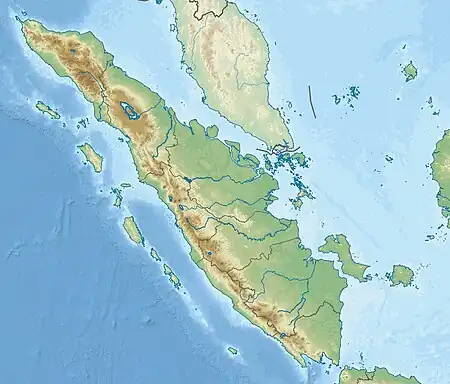| Mount Masurai | |
|---|---|
| Gunung Masurai | |
.jpeg.webp) Masurai as seen from Lubuk Pungguk Village, Jangkat | |
| Highest point | |
| Elevation | 2,916 m (9,567 ft) |
| Prominence | 2,916 m (9,567 ft) |
| Listing | Ultra Ribu |
| Coordinates | 02°30′09″S 101°51′30″E / 2.50250°S 101.85833°E |
| Geography | |
| Parent range | Barisan Mountains |
| Geology | |
| Mountain type | Stratovolcano |
| Volcanic arc/belt | Pacific Ring of Fire |
| Last eruption | Pleistocene[1] |
Mount Matsurai, natively known as Gunung Masurai, is a large complex of inactive stratovolcanoes in Jambi, Sumatra, Indonesia. The volcano attains an elevation of 2,916 m (9,567 ft) above sea level.[1]
Geology
Mount Masurai is part of the greater Barisan Mountains, which formed due to offshore subduction of the Indo-Australian Plate beneath the Sunda Plate along the Sunda megathrust. The volcanic comples is situated in the Sungai Penuh pull-apart basin; caused by offsets along two segments of the Great Sumatran Fault. In the southern section of the basin, closer to Mount Masurai, the basin becomes wider.[2]
Mount Matsurai contains two crater lakes; Kumbang Lake and Merbuk Lake; near the summit cone. The summit cone occupies the western remnant of a half-caldera, 7 km in diameter. The rim of the half-caldera is at an altitude of 2,000 m (6,600 ft)–2,250 m (7,380 ft). A third lake, Blue Lake, located in the caldera, is thought to be remnants of a parasitic eruption; one of many around the area.[3]
Flora
Two species of tropical carnivorous pitcher plants; Nepenthes spathulata and Nepenthes singalana notably overlap each other. The plants, which cannot be definitively assigned to either appear intermediate in form between these two species. It was discovered by botanist Charles Clarke, and written in his monograph Nepenthes of Sumatra and Peninsular Malaysia.[4]
Climbing
Kumbang Lake is a popular feature of the volcano, often visited by climbers on their way to the summit.[5]
See also
References
- 1 2 "Masurai". Global Volcanism Program. Smithsonian Institution.
- ↑ Hirofumi Muraoka; Masaaki Takahashi; Herry Sundhoro; Sjafra Dwipa; Yoshio Soeda; Manabu Momita; Kanichi Shimada (2010). "Geothermal Systems Constrained by the Sumatran Fault and Its Pull-Apart Basins in Sumatra, Western Indonesia" (PDF). Proceedings World Geothermal Congress 2010.
- ↑ Asep Rohiman; Dipowiguno Prijanto; Arief Prabowo; Antonius Ratdomopurbo; Ruly Setiawan; Mutiara Effendi; Eko Wahyudi (2017). "Geochemical Characteristics of Volcanic Rocks from The Mt.Masurai's Caldera, Jambi, Indonesia". Journal of Physics: Conference Series. 1204 (12070): 012070. doi:10.1088/1742-6596/1204/1/012070. S2CID 164449741.
- ↑ Clarke, C.M. 2001. Nepenthes of Sumatra and Peninsular Malaysia. Natural History Publications (Borneo), Kota Kinabalu.
- ↑ Wildan Carbon (9 July 2019). "Gunung Masurai Jambi, Surganya Pendaki Sleeping Mountain". travelingyuk.com (in Indonesian). Archived from the original on 2022-02-13. Retrieved 12 February 2022.
